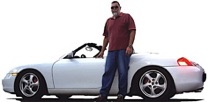
Definition:
A brake is a device for slowing or stopping the motion of a machine or vehicle, or alternatively a device to restrain it from starting again.
From our Physics classes we should remember that energy is never lost or created, just transformed. So, since a car in motion has kinetic energy, and in order to slow it down or stop it, that kinetic energy must be transformed to another type of energy. This is the brake’s job. The kinetic energy is transformed into heat, by means of friction between the brake pads and the brake rotors.

The kinetic energy increases with the mass of the vehicle and with the square of the velocity (v): E = m * v2
In the graph of Energy/Speed you can see how as the speed
doubles, the vehicle has 4 times more energy, and the brakes
must dissipate 4 times as much energy to stop it, using 4 times the distance.
Energy
(m)

This is perfectly illustrated in the Bob Chapman photo on the right where you can see the heat being dissipated by the front rotors of the Flying Lizard’s GT2 2008 Sebring winner
Enough with the theory. Let’s get to work.
To determine whether you need new brake pads without having to rely on, or to wait for the brake light to go on, take a look at them. You can see the pads even with most wheels in place.
You can see the pad material
between the rotor or disk
and the pad’s backing plate.
The brake pad wear limit with sensors is 2.5 mm
(0.1 in) and without sensors is 2.0 mm (0.08 in).
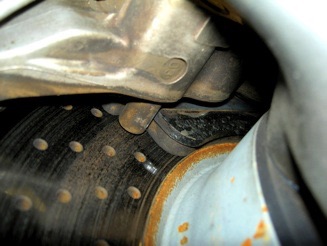

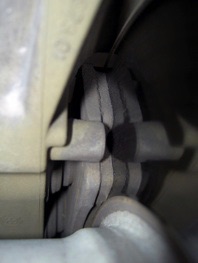
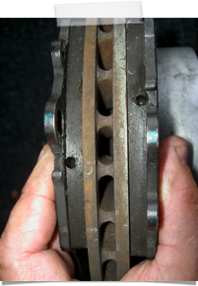
If you replace the pads before the brake light comes on, you can re-use the brake sensors. If the brake light goes on, then you probably need to replace the worn sensor(s).
The following brake pad replacement instructions apply to front and/or rear brakes.
Note that the pads are different between front and rear, but the procedure is the same.
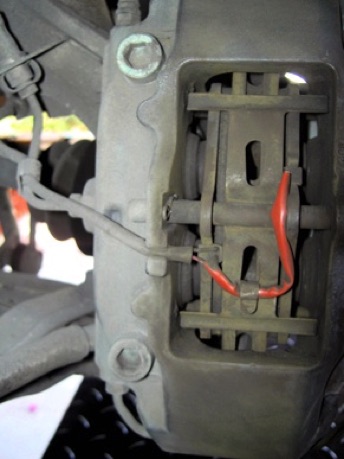
a) Loosen the wheel lugs
b) Safely raise the car and support on stand(s)
c) Remove the wheel(s)
Remove the wear sensors
I’ve found that the easiest
way is using long-nose pliers
and squeezing the outside tabs
while at the same time pulling out
the sensor from the pad.
Leave the wire harness hanging until
you replace the new pads.
Remove the clip from the retaining pin
The clip pulls right out.
You may have to rotate the retaining pin
using pliers, to better position the clip for
easier removal.
Using your finger, put pressure on the spring clip,
into the caliper, to relieve pressure on the retaining
pin. Push the pint out.
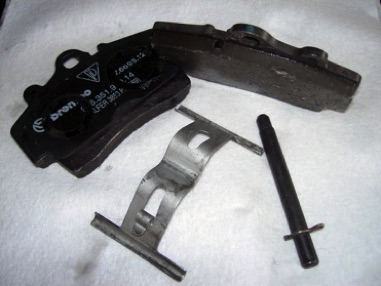
Now, clean the retaining pin and replace the pin so you don’t loose it.
Clean the spring clip as well.
To remove the old pads, simply pull them up and out. If they are too tight pry the pad back against the caliper using a screwdriver blade or similar, this will make the caliper piston retract and release the pad.
Before replacing the new pads you may have to push back the caliper pistons I use a piece of wood 1 inch square by 12 inches long for prying back the pistons.
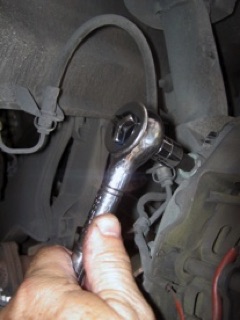
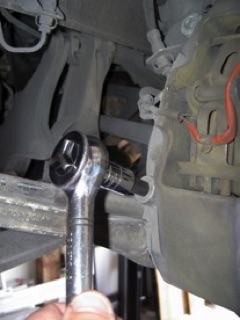

To remove the rotor(s) you’ll need to first remove the caliper(s).
The easiest way is to use a 10 mm hexagonal bit socket and a ratchet.
Two 10 mm hex bolts hold each caliper to the wheel carrier
Once these two bolts are removed you need to move the caliper out of the way to remove the rotor.
Fashion a hanger for the caliper from a wire clothes hanger and hang the whole assembly from the strut spring.
This is done so as to not put too much stress on the flexible brake line.
You need to remove the flexible line bracket retaining bolt (10 mm)
You can now safely work on the rotor without worrying about breaking a flexible brake line.
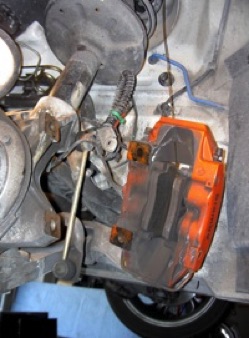
Since the rotors also wear down, you need to monitor their thickness as well as the thickness of the pads.
You will notice that the rotors start developing a narrow lip on the edge of the rotor.
When this lip gets to be 1 mm, it’s time to replace the rotor.
As a rule of thumb, you should replace the front rotors with every second pad replacement.
Keep in mind that due to the built-in brake bias, the front pads and rotors will wear much quicker than the rears.
The rotor is secured to the wheel hub with two Phillips head screws.
Remove these two screws
and pull the rotor.
In some case, due to corrosion it may be difficult to remove the rotor initially. If that’s the case tap it out from the inside using a piece of wood as a buffer.
Keep in mind that to remove the rear rotors the hand brake must be released.
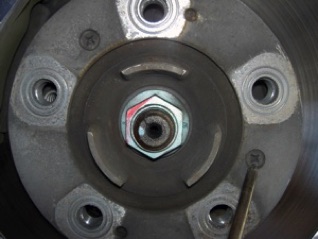
Re assemble in inverse order and tighten to the following specs:
• Brake to rotor hub .......................................... 7.5 lb-ft (10 Nm)
• Brake caliper to wheel bearing carrier ............ 63 lb-ft (85 Nm)
• Brake line bracket to wheel bearing carrier.... 7.5 lb-ft (10 Nm)
• Wheel to wheel hub ........................................96 lb-ft (130Nm)
Happy Boxstering,

MAINTENANCE
Brake Pads & Rotors
